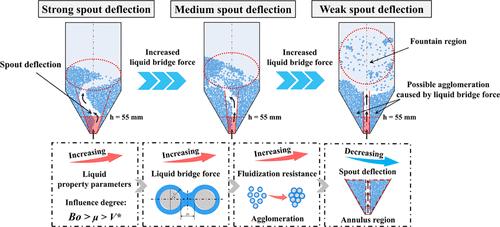Effects of Liquid Property Parameters on Spout Deflection in a Liquid-Containing Gas–Solid Spouted Bed Reactor: Quantitative Characterization and Action Mechanism
IF 3.9
3区 工程技术
Q2 ENGINEERING, CHEMICAL
引用次数: 0
Abstract
Spout deflection is commonly observed in liquid-containing gas–solid spouted bed reactors (LC-GSSBRs) and can hinder their industrial application. However, the underlying mechanism of spout deflection remains insufficiently understood. To address this gap, the computational fluid dynamics-discrete element method approach is applied to investigate the effects of liquid property parameters (surface tension, liquid viscosity, and liquid content) on spout deflection. By the introduction of the particle number difference as a quantitative indicator, the liquid-induced mechanism of spout deflection is elucidated from the perspective of liquid bridge forces. The work demonstrates that surface tension is the dominant factor affecting spout deflection, which progressively weakens as the surface tension increases. In contrast, the inhibitory effect of liquid viscosity on spout deflection becomes evident only under low surface tension, primarily because surface tension suppresses the enhancing effect of viscosity on liquid bridge forces. Although the liquid content shows insignificant correlation with spout deflection, it exhibits a significant positive correlation with liquid bridge forces under high surface tension. Overall, changes in liquid property parameters influence liquid bridge forces, which, in turn, alter particle fluidization resistance and lead to distinct spout deflection behaviors under varying operating conditions. This work comprehensively elucidates the action mechanism of liquid property parameters on spout deflection, providing guidance for further investigation into the deflection mechanism and offering important insights for regulating spout deflection.

液体性质参数对含液气固喷流床反应器喷嘴偏转的影响:定量表征及作用机理
在含液气固喷淋床反应器(LC-GSSBRs)中,喷嘴偏转是常见的现象,可能会阻碍其工业应用。然而,喷口偏转的潜在机制仍然没有得到充分的了解。为了解决这一差距,应用计算流体动力学-离散元方法研究了液体性质参数(表面张力、液体粘度和液体含量)对喷口偏转的影响。通过引入颗粒数差作为定量指标,从液桥力的角度阐述了液致喷口偏转的机理。研究表明,表面张力是影响喷嘴挠度的主要因素,随着表面张力的增大,喷嘴挠度逐渐减弱。相比之下,液体粘度对喷口偏转的抑制作用仅在低表面张力下才显现出来,这主要是因为表面张力抑制了粘度对液桥力的增强作用。在高表面张力条件下,液量与液桥力呈显著正相关,但与喷嘴挠度相关性不显著。总的来说,液体性质参数的变化会影响液桥力,而液桥力又会改变颗粒流化阻力,从而导致不同操作条件下不同的喷嘴偏转行为。该工作全面阐明了液性参数对喷嘴偏转的作用机理,为进一步研究喷嘴偏转机理提供了指导,并为调节喷嘴偏转提供了重要见解。
本文章由计算机程序翻译,如有差异,请以英文原文为准。
求助全文
约1分钟内获得全文
求助全文
来源期刊

Industrial & Engineering Chemistry Research
工程技术-工程:化工
CiteScore
7.40
自引率
7.10%
发文量
1467
审稿时长
2.8 months
期刊介绍:
ndustrial & Engineering Chemistry, with variations in title and format, has been published since 1909 by the American Chemical Society. Industrial & Engineering Chemistry Research is a weekly publication that reports industrial and academic research in the broad fields of applied chemistry and chemical engineering with special focus on fundamentals, processes, and products.
 求助内容:
求助内容: 应助结果提醒方式:
应助结果提醒方式:


